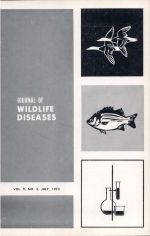Four raccoons and one of two skunks inoculated with brain suspensions containing the transmissible mink encephalopathy (TME) agent developed a neurologic disease characterized by alterations of behavior, by incoordination and by slowing of motor activity. Histologic examination of the brains revealed a spongiform polioencephalopathy as is characteristic of the disease in mink. Fourteen ferrets inoculated with TME brain suspensions remained asymptomatic until sacrifice 2 years post-inoculation. A spongiform degeneration of gray matter was present in all ferret brains. However, the lesions and their topographical distribution were distinctly different from those seen in the brains of all other species susceptible to TME infection.
How to translate text using browser tools
1 July 1973
TRANSMISSIBLE MINK ENCEPHALOPATHY IN CARNIVORES: CLINICAL, LIGHT AND ELECTRON MICROSCOPIC STUDIES IN RACCONS, SKUNKS AND FERRETS
ROBERT J. ECKROADE,
GABRIELE M. ZuRHEIN,
ROBERT P. HANSON





